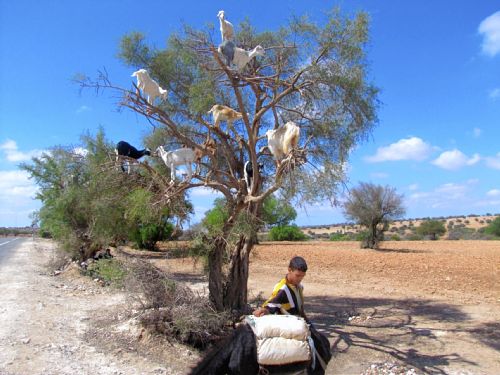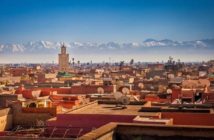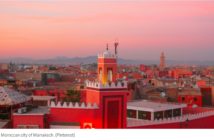Post-Gazette.com
By Christine H. O’Toole

Christine H. O”Toole
Yes. goats in a tree.
FEZ, Morocco — Yunis, a Fez university student in white jeans, halted near the ornate Blue Gate of Fez and raised three fingers.
“Before we enter the medina, you must learn three words in Arabic,” he said, in crisp English. “Bellek means get out of the way. Shokrun means thanks, and lehmeans no. So: leh shokrun, no thanks.” With that, he led us through a narrow passage and into the dim, glorious, thousand-year-old chaos of the Moroccan market.
If you go
MOROCCO
Getting there
While many airlines fly direct from Europe to Marrakesh, Fez and other Moroccan cities, all U.S. direct flights arrive in Casablanca, with connections to other major cities. In November, round-trip fares from Pittsburgh on Delta Airlines start at $958.
Where to stay:
Palais Faraj — 16-18 Quartier Ziat, Derb Bensouda, 30000 Old Fez,www.palaisfaraj.com/EN/. This elegant riad, reopened after extensive renovations including elevators and swimming pool, offers suites starting in low season (June-September) at $246; high season $300. Its rooftop restaurant, La Terrasse, specializes in traditional Moroccan cuisine.
La Maison Arabe — Derb Assehbé, Bab Doukkala, Marrakesh Médina;www.maisonarabe.com. A five-minute walk from the main city square of Jemaa el Fna, within the medina, this five-star property is generally considered the finest riad in town. Winston Churchill drank in the bar; international food writers hail the hotel’s famous cooking school. Rate from $700 in low season, $875 in high season.
Delano Marrakesh — Angle Av. Echouhada et Rue des Temples;www.delanomarrakech.com. This ultra-modern luxury property in the upscale Hivernage district opened in September with 71 rooms (including 27 suites), a rooftop pool and sushi bar and spa. Special overnight packages including dinner for two in the hotel’s Italian restaurant from $418.
Kasbah du Toubkal, Imlil –www.kasbahdutoubkal.com. In the Toubkal National Park in the High Atlas, beyond the main road system, the Kasbah offers a variety of rooms, from family-style Berber salons to deluxe ensuite rooms. Standard doubles with breakfast from $168; other meals from 15 to 35 euros. Guided treks available.
Where to eat:
In Fez, Maison Bleue, 2, Place Batha Fes-Medina, www.maisonbleue.com. Owned by the Moroccan Tassi family, this is the oldest guesthouse and restaurant in the Fez medina.
More tips:
Casual Western dress is appropriate in Morocco’s big cities. Native women usually wear head scarves but generally are not veiled.
In the souks, or markets, it’s appropriate to bargain for goods, but not for food and drink. In the medina, cafes frown on single women sitting outside; go with a group, or choose a table inside.
Always choose bottled water or soft drinks, or boiled tea and coffee.
Most places accept both euros and the Moroccan currency dirham. And, of course, guard your wallet.
Photo etiquette: Many Moroccans, especially women, refuse to have their pictures taken. Even at a distance, a subject may put up a hand to shield his or her face. To be polite, ask first. The subject who agrees may want a dirham or two (about a dime).
Sacks of fresh saffron, harvested from local fields of crocus flowers. False teeth. Handmade brass lanterns and thick pottery. Tiny fried doughnuts, called svinche. Blue satin wedding gowns. Live chickens (strangled, beheaded, defeathered and disemboweled while you wait). Coils of dried figs. Bushels of damp mint. And as I glanced up to the latticed roof of the passage, I felt hot breath and a strong shoulder pushing me from behind. Both belonged to a donkey. “Bellek!” its driver bellowed. I leapt to safety. Overhead, a muezzin began his sonorous call to midday prayer.
In this ancient walled city, only one thing is free: sensory overload.
After a visit to this kingdom on the northwestern shoulder of Africa, it’s not the grand monuments or events that I recall. It’s the light touch of a head-scarfed artist, gently tattooing my hand with a swirl of henna dye; the shockingly sweet gulp of mint tea from a tiny glass; the stink of the leather tanneries and the sharp scent of eucalyptus in the fog of the hammam, the traditional steam bath; and the brilliant contrast of deep blue skies and white hills.
With a history that blends Arab, Berber and French culture, and a geography that offers a long Atlantic coastline, a slice of the Sahara, and some of the highest peaks on the continent, Morocco welcomes Westerners. Long favored by Europeans looking for a fast sunbaked getaway, the kingdom is secular –and safe, if you avoid the water (and those donkeys).
On a weeklong visit to Fez, Marrakesh and the nearby Atlas Mountains, we found that Moroccan cities guard their secrets. Most imperial palaces and mosques aren’t open to the public, and even elegant landmarks are often hidden behind walls.
“In Morocco, we don’t care what the outside of the house looks like,” explained one of our hosts. “We concentrate on making the inside most beautiful.”
Entering the Palais Faraj in Fez, we understood. Generations of wealthy families shared these thick-walled riads, homes built around central garden courtyards with fountains. Now, many have been restored as small hotels that showcase the signature geometric decor and cuisine of the country.
A rich cuisine
Our rooftop dinner began with a surprise: wine from the nearby vineyards of Meknes. Wine, in a country that’s 98 percent Sunni Muslim? Of course, shrugged our urbane host — after all, the Romans made it at nearby Volubilis 2,000 years ago. In this cosmopolitan city, where Western dress is as common as headscarves and the traditional djellaba tunic, bars and cafes are popular. Credit the French, who colonized Morocco before 1956.
Now riads celebrate traditional cuisine. After small dishes of cool salads, a huge platter appeared: an enormous tagine, or stew, of chicken simmered with spices and slathered in pumpkin confit; a steaming platter of couscous, and a crunchy pastille, pastry layered with cream and cinnamon sugar.
A few days later in Marrakesh, we dined outside again — but with a cast of thousands and a different result.
In a dry valley ringed by the High (central) Atlas Mountains, this city — six hours from Fez and three from Casablanca — has the sunny, laid-back feel of Palm Springs. At the city limits, we passed BMW dealerships, hookah bars and dance clubs. But where to find dinner?
The answer was easy. We followed the aromas — and the crowds — to Jemaa el Fna. The famous central square wakes at sunset, when food vendors fire up their grills for a barbecue that seems to serve the entire city.
We slid onto a bench at a counter and ordered chewy chicken and beef kebabs, served with a side of sauteed eggplant and fresh baked bread. Oranges, figs and yellow melons, sliced by other vendors, made a portable dessert.
We wandered from the square to a tiny passage, barely wide enough for a wagon. A torch lit the entrance to Maison Arabe, another elegant riad where we’d spend the night. We were welcomed in elegant Arab tradition, with rosewater poured from a silver ewer on our sticky hands.
At breakfast the next morning, half of our companions were missing. Finally Caroline arrived, dropping into her seat with a sigh and a question.
“Was anyone else sick last night?”
Call it the revenge of Jemaa el Fna: a few bites of street food felled half our group. Not a single person complained; we agreed that the exotic experience outweighed the risk. Later in the day, we rallied for a restorative visit to a luxurious hammam.
The hammam is the all-girl enclave where Islamic women gather to bathe, laugh and gossip. Part ritual and part spa, it begins with a steambath, followed by a slathering of black olive oil soap. Then the masseuses stretched us out on a hot stone surface for a scrub-down with a rough loofah. The session ended with a vigorous shampoo, followed by a splash of cool water.
Credit the healing power of the water and the powerful rub-down: revived, we were ready to ascend into the Atlas.
Mountains that move you
The mountains that rise outside Marrakesh were the biggest surprise of the trip. They’re also among the biggest on the continent. Jbel Toubkal, our destination, soars to 13,000 feet (4,100 meters), second only to Kilimanjaro. After a 90-minute drive that corkscrewed up a narrow pass, we arrived at Imlil, a village carved from stone. But our journey hadn’t ended — just the road.
A gasping, 15-minute hike up a slick path carried us to Kasbah du Toukbal, a base camp for trekkers assembling to ascend the mountain. We were going only as far as the Kasbah (our luggage arrived later, on donkeys). The British medical students who puffed up the path behind us would acclimate here, then ascend farther, camping overnight before a final assault.
We walked onto a sunlit terrace that seemed only an arm’s length from the snow-capped summit. In fact, the cozy guesthouse was two days’ climb below the peak. Here, we were greeted with a dish of dates, to be dipped in goats’ milk: a Berber welcome, instead of an Arab one.
Long before the Arabs infiltrated the region, the Berbers fought the Romans and Byzantines (Kasbah refers to a fortress, Hollywood to the contrary). Their traditional symbol of the “free man” marks walls, rugs and pottery.
Now mostly Islamic, the local tribes honor old traditions and speak Berber, Arabic and often French. The village men work at the guesthouse as guides and cooks; women, many of them with tattooed faces, stay for the most part behind closed doors.
But that’s changing. Mike McHugo, the Englishman who has worked for three decades to make the Kasbah a sustainable business, donates some profits from the business to support Education for All, a foundation that helps rural girls receive secondary education.
That night we gathered by a wood stove for tagine and couscous. Outside the night was cold and misty. A loudspeaker echoed up the valley with the sunset call to prayer, and smoke from the village braziers carried the scent of roasting lamb. I couldn’t see a thing, but the scents and sounds painted an indelible picture of the Moroccan mountains.






